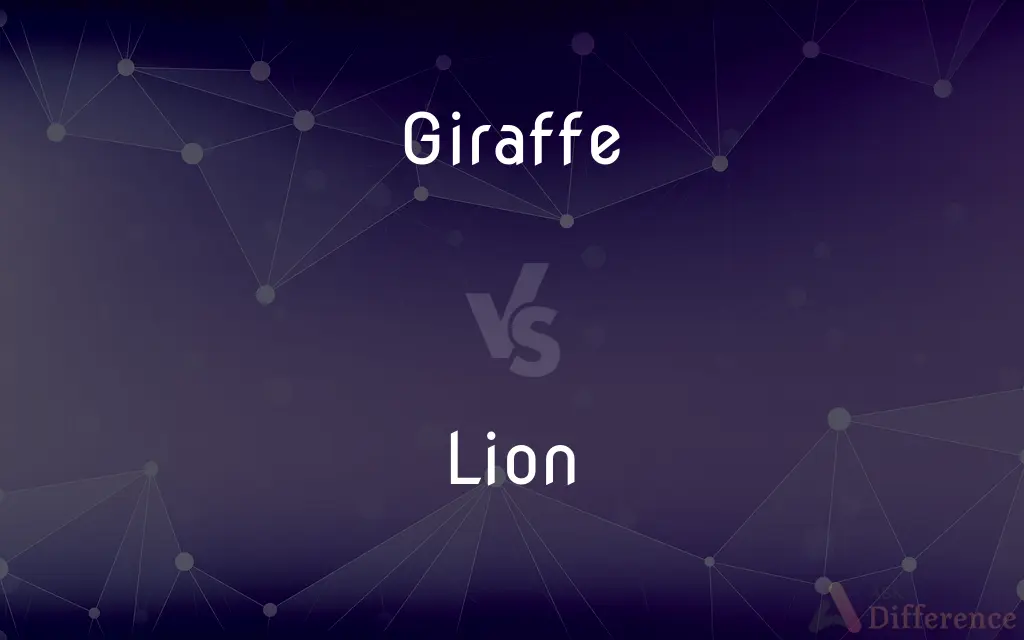Giraffe vs. Lion — What's the Difference?
By Fiza Rafique & Maham Liaqat — Updated on April 5, 2024
Giraffes are the tallest land animals, adapted for browsing foliage high above, while lions, known as "king of the jungle," are apex predators specializing in cooperative hunting.

Difference Between Giraffe and Lion
Table of Contents
ADVERTISEMENT
Key Differences
Giraffes, recognized for their long necks and legs, have evolved to feed on leaves and twigs from treetops, out of reach of other herbivores. In contrast, lions are carnivorous predators that rely on their strength, speed, and strategic group hunting tactics to catch their prey, which includes a variety of mammals.
The giraffe's height, which can reach up to 18 feet, offers both a feeding advantage and a vantage point to spot predators from a distance. On the other hand, lions utilize their powerful physique and stealth, often stalking their prey in groups before launching a coordinated attack.
Socially, giraffes are relatively solitary but can be found in loose aggregations that change frequently. Lions, however, live in structured groups known as prides, consisting of related females, their offspring, and a small number of adult males, highlighting a complex social structure.
Giraffes use their long legs to escape predators, capable of running at speeds up to 35 mph. Whereas lions, who can reach speeds of 50 mph in short bursts, use their speed primarily for hunting, showcasing their role as predators versus the giraffe's prey status.
Giraffes communicate through a variety of sounds and visual signals, with recent studies suggesting they also communicate infrasonically. Lions are known for their roaring, which can be heard up to 5 miles away, serving as a means to communicate territory and presence to other lions.
ADVERTISEMENT
Comparison Chart
Habitat
Savannahs, grasslands, and open forests
Grasslands, savannahs, and dense bush
Diet
Herbivorous, primarily leaves and twigs
Carnivorous, preying on a variety of mammals
Social Structure
Loose aggregations, not strongly territorial
Prides with complex social structures
Predation & Defense
Uses height to spot predators and can run at high speeds to escape
Apex predators, rely on strength and group tactics for hunting
Communication
Visual signals and possibly infrasonic sounds
Roaring to communicate territory and presence
Compare with Definitions
Giraffe
Lives in savannahs and open forests, where it grazes on treetop vegetation.
We spotted a group of giraffes moving gracefully across the savannah.
Lion
Uses speed and power for hunting, capable of reaching 50 mph in short bursts.
In a burst of speed, the lion caught up to the antelope, showcasing its predatory prowess.
Giraffe
A tall mammal known for its long neck and legs, adapted to browsing high foliage.
The giraffe stretched its neck to reach the tender leaves at the tree's top.
Lion
Known as the "king of the jungle," an apex predator in its habitat.
The lion's roar echoed through the savannah at dusk.
Giraffe
Not territorial, forming loose, changeable groups for social interaction.
A solitary giraffe joined a nearby group to feed in the late afternoon.
Lion
Employs teamwork and strategy in hunting to catch prey.
The lions coordinated their attack, encircling a group of unsuspecting zebras.
Giraffe
Capable of running at speeds up to 35 mph to escape predators.
The giraffe fled across the plain, outpacing the chasing predator with ease.
Lion
Lives in prides, consisting of related females, their offspring, and a few males.
The pride of lions rested in the shade, keeping a watchful eye on their territory.
Giraffe
Communicates through body language and possibly low-frequency sounds.
The mother giraffe used subtle visual signals to communicate with her calf.
Lion
Communicates through roars, signaling territory and presence to others.
At night, the lion's roar signaled his dominance over the territory.
Giraffe
The giraffe (Giraffa) is an African artiodactyl mammal, the tallest living terrestrial animal and the largest ruminant. It is traditionally considered to be one species, Giraffa camelopardalis, with nine subspecies.
Lion
The lion (Panthera leo) is a large felid of the genus Panthera native mainly to Africa. It has a muscular, deep-chested body, short, rounded head, round ears, and a hairy tuft at the end of its tail.
Giraffe
A large African mammal with a very long neck and forelegs, having a coat patterned with brown patches separated by lighter lines. It is the tallest living animal.
Lion
A large carnivorous feline mammal (Panthera leo) of Africa and northwest India, having a short tawny coat, a tufted tail, and, in the male, a heavy mane around the neck and shoulders.
Giraffe
An African ruminant mammal (Giraffa camelopardalis) having a very long neck and legs, a tan coat with orange-brown to black blotches, and short horns. It is the tallest land animal, often reaching a height of 5 meters (16 feet).
Lion
A mountain lion.
Giraffe
A ruminant, of the genus Giraffa, of the African savannah with long legs and highly elongated neck, which make it the tallest living animal; yellow fur patterned with dark spots, often in the form of a network; and two or more short, skin-covered horns, so-called; strictly speaking the horn-like projections are ossicones.
Lion
A very brave person.
Giraffe
A giraffe unicycle.
Lion
A person regarded as fierce or savage.
Giraffe
(Cockney rhyming slang) A laugh.
Are you having a giraffe?!
Lion
A noted person; a celebrity
A literary lion.
Giraffe
A very tall individual.
Lion
Lion See Leo.
Giraffe
An African ruminant (Giraffa camelopardalis formerly Camelopardalis giraffa) related to the deers and antelopes, but placed in a family (Giraffidae) by itself; the camelopard. It is the tallest of quadriped animals, being sometimes twenty feet from the hoofs to the top of the head. Its neck is very long, and its fore legs are much longer than its hind legs. There are three types, having different patterns of spots on the pelt and different territories: the Reticulated Giraffe, the Masai Giraffe, and the Uganda Giraffe. Intermediate crosses are also observed.
Lion
A big cat, Panthera leo, native to Africa, India and formerly much of Europe.
Tigers and lions share a common ancestor from a few million years ago.
Giraffe
Tallest living quadruped; having a spotted coat and small horns and very long neck and legs; of savannahs of tropical Africa
Lion
(in particular) A male lion, as opposed to a lioness.
Lion
(by extension) Any of various extant and extinct big cats, especially the mountain lion.
Lion
A Chinese foo dog.
Lion
An individual who shows strength and courage, attributes associated with the lion.
Lion
A famous person regarded with interest and curiosity.
Lion
A light brown color that resembles the fur of a lion. en
Lion
(historical) An old Scottish coin, with a lion on the obverse, worth 74 shillings.
Lion
Of the light brown color that resembles the fur of a lion.
Lion
A large carnivorous feline mammal (Panthera leo, formerly Felis leo), found in Southern Asia and in most parts of Africa, distinct varieties occurring in the different countries. The adult male, in most varieties, has a thick mane of long shaggy hair that adds to his apparent size, which is less than that of the largest tigers. The length, however, is sometimes eleven feet to the base of the tail. The color is a tawny yellow or yellowish brown; the mane is darker, and the terminal tuft of the tail is black. In one variety, called the maneless lion, the male has only a slight mane.
Lion
A sign and a constellation; Leo.
Lion
An object of interest and curiosity, especially a person who is so regarded; as, he was quite a lion in London at that time.
Such society was far more enjoyable than that of Edinburgh, for here he was not a lion, but a man.
Lion
Large gregarious predatory feline of Africa and India having a tawny coat with a shaggy mane in the male
Lion
A celebrity who is lionized (much sought after)
Lion
(astrology) a person who is born while the sun is in Leo
Lion
The fifth sign of the zodiac; the sun is in this sign from about July 23 to August 22
Common Curiosities
Why do lions roar?
Lions roar to communicate their presence, establish territory, and maintain contact with other pride members over large distances.
What is the social structure of a lion pride?
A lion pride consists of related females, their young, and a few adult males, forming a complex social structure based on cooperation and territory.
Can giraffes communicate with each other?
Yes, giraffes communicate through body language and have been suggested to use infrasonic sounds that are inaudible to humans.
Why are giraffes so tall?
Giraffes are tall to access food in treetops that other herbivores cannot reach, providing them with a competitive feeding advantage.
How do giraffes sleep?
Giraffes sleep standing up or by lying down with their necks resting back on their bodies, but only for short periods due to vulnerability to predators.
What kind of prey do lions prefer?
Lions are opportunistic hunters that prey on a variety of mammals, from small ones like hares to large ones like buffaloes and giraffes.
What challenges do lions face in the wild?
Lions face challenges such as habitat loss, conflicts with humans, and competition for food with other large predators.
How do giraffes mate?
Male giraffes compete for females through necking (striking each other with their necks) to establish dominance and win mating rights.
Are giraffes endangered?
Some giraffe populations are stable, but others are facing threats from habitat loss and poaching, leading to a decline in their numbers.
What is the lifespan of a giraffe compared to a lion?
Giraffes can live up to 25 years in the wild, while lions typically live around 10-14 years due to the physical demands of their predatory lifestyle.
How do lions interact with other predators?
Lions compete with other large predators like hyenas and leopards for food, often dominating due to their size and social structure.
How do giraffes defend themselves from predators?
Giraffes defend themselves by using their height to spot predators from afar and running swiftly to escape, and they can also deliver powerful kicks.
How do giraffes and lions interact in the wild?
Giraffes and lions interact as prey and predator, with lions sometimes preying on young or sick giraffes.
What conservation efforts are in place for giraffes and lions?
Conservation efforts for giraffes and lions include habitat protection, anti-poaching measures, and initiatives to reduce human-wildlife conflicts.
What adaptations help lions hunt?
Lions have adaptations like powerful muscles, stealthy movements, and cooperative hunting strategies to effectively catch their prey.
Share Your Discovery

Previous Comparison
Dolphin vs. Beluga
Next Comparison
Case vs. SuitcaseAuthor Spotlight
Written by
Fiza RafiqueFiza Rafique is a skilled content writer at AskDifference.com, where she meticulously refines and enhances written pieces. Drawing from her vast editorial expertise, Fiza ensures clarity, accuracy, and precision in every article. Passionate about language, she continually seeks to elevate the quality of content for readers worldwide.
Co-written by
Maham Liaqat















































